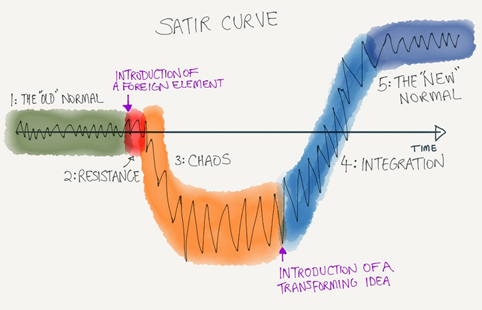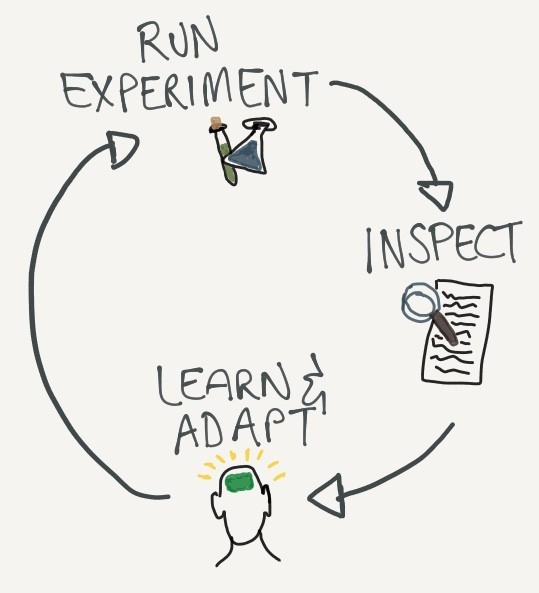Share this
Change always fails - Lean Change brings a new way
by Kirsten Eriksen on 28 August 2018

Why does change always fail?
It’s a bold statement and one that I bet a lot of you are already arguing against in your head. But think for a minute, when was the last time you were involved in a change that actually delivered what it was supposed to?
In both IT and business, we see a lot of change, we are inundated with it. We are in the era of digital disruption, and if you haven't been disrupted lately, you're probably one of the few. In this post I'd like to look at some of the things I think we could do better when it comes to change.
The Satir Curve shows why big change fails
Firstly, a brief statement on what happens when change is introduced to an existing system (in this post I mean system in the broader 'systems thinking' context, not a computer system). The Satir Curve shows us that when a foreign element like change is introduced to a system involving people, there is immediate resistance, then descent into chaos. Once a transforming idea occurs, for example, the person the change is impacting gaining an understanding of what's in it for them, we start to move into integration. Subsequently performance gradually improves. It's important to note that if the change is the wrong change, productivity will not increase.

In general, the bigger the change the further an organisation is likely to fall into chaos once change starts. At the same time these organisations will have less tolerance for a performance drop. This paradox almost guarantees that any organisation that requires a big change will not be able to successfully execute that change. Sometimes it feels as though we use large change management programs because we don't know there's another way.
So… what can we do differently? Well I think the Lean Change Method is a great place to start.
The Lean Change Method and minimum viable change
At the heart, the Lean Change Method advocates making the least change possible (A.K.A. minimum viable change), introducing it as an experiment and using a Lean Change Canvas to track and pivot as required. The focus of this method is that the change is co-created and validated with the people that are impacted by the change. Lean Change Method is a cyclic activity, which emphasises creating true value through feedback loops, and then adjusting, pivoting or optimising the change. Alternatively, if it’s not working, discard it and move onto the next experiment. Specifically, you don't embed a change until you know it's the right thing to do in practice, rather than in theory.

The book The Lean Change Method by Jeff Anderson is a guide for introducing Agile practices into organisations and provides a method that will work well for any kind of change.
What does the Lean Change Method do that other change practices don't?
In my opinion the two areas that organisations fail most when introducing change is the human side of change and the inspect and learn/adapt cycle.
We're pretty terrible at the human side of change, which I see as the activity to get the people to want to change and to embrace change. This is something I'm passionate about. I'll be presenting on this at Pink19 in Las Vegas in February 2019, so expect to hear more from me on this topic in the coming months! But this post is to give you some general information on a new way to look at implementing change, so I'll move on…
Inspect and learn/adapt are areas that are also often overlooked or just not done with the rigour needed. Once a change is introduced, it's often not inspected to see if it was right and of value. On the occasions where inspection does happen, unless the change broke something important, the only action taken is often to simply document "lessons learned". The reason for this is often the sheer scale of activity needed to pivot if required. It is not unlike the large waterfall projects we see too often in IT, where the feedback loops are long and by the time the project identifies it's on the wrong course, the sunk cost means it is too late to change to the right direction.
Using the Lean Change Method means you're only investing what you need to in the experiment, ensuring it works and then scaling it out, giving you flexibility to experiment and inspect to find out what really provides value.
The Lean Change method is one tool among many in the change management space and it's no silver bullet. It is however a different approach from most change programmes I've seen in action. If you were thinking of adopting the Lean Change Method as one of your tools, then I'd suggest doing an experiment using the Lean Change Method to see if it is a tool that will work for you.
Equinox IT has a number of consultants that can help you in this, and many other areas of change. We're always happy to have a chat to see if we can help you. You can get in contact with me through my consultant profile page.
Kirsten Eriksen is a Senior Consultant specialising in business analysis and human-centred change, based in our Wellington office.
Share this
- Agile Development (153)
- Software Development (126)
- Agile (76)
- Scrum (66)
- Application Lifecycle Management (50)
- Capability Development (47)
- Business Analysis (46)
- DevOps (43)
- IT Professional (42)
- Equinox IT News (41)
- Agile Transformation (38)
- IT Consulting (38)
- Knowledge Sharing (36)
- Lean Software Development (35)
- Requirements (35)
- Strategic Planning (35)
- Solution Architecture (34)
- Digital Disruption (32)
- IT Project (31)
- International Leaders (31)
- Digital Transformation (26)
- Project Management (26)
- Cloud (25)
- Azure DevOps (23)
- Coaching (23)
- IT Governance (23)
- System Performance (23)
- Change Management (20)
- Innovation (20)
- MIT Sloan CISR (15)
- Client Briefing Events (13)
- Architecture (12)
- Working from Home (12)
- IT Services (10)
- Data Visualisation (9)
- Kanban (9)
- People (9)
- Business Architecture (8)
- Communities of Practice (8)
- Continuous Integration (7)
- Business Case (4)
- Enterprise Analysis (4)
- Angular UIs (3)
- Business Rules (3)
- Java Development (3)
- Lean Startup (3)
- Satir Change Model (3)
- API (2)
- Automation (2)
- GitHub (2)
- Scaling (2)
- Toggles (2)
- .Net Core (1)
- Diversity (1)
- Security (1)
- Testing (1)
- February 2024 (3)
- January 2024 (1)
- September 2023 (2)
- July 2023 (3)
- August 2022 (4)
- August 2021 (1)
- July 2021 (1)
- June 2021 (1)
- May 2021 (1)
- March 2021 (1)
- February 2021 (2)
- November 2020 (2)
- September 2020 (1)
- July 2020 (1)
- June 2020 (3)
- May 2020 (3)
- April 2020 (2)
- March 2020 (8)
- February 2020 (1)
- November 2019 (1)
- August 2019 (1)
- July 2019 (2)
- June 2019 (2)
- April 2019 (3)
- March 2019 (2)
- February 2019 (1)
- December 2018 (3)
- November 2018 (3)
- October 2018 (3)
- September 2018 (1)
- August 2018 (4)
- July 2018 (5)
- June 2018 (1)
- May 2018 (1)
- April 2018 (5)
- March 2018 (3)
- February 2018 (2)
- January 2018 (2)
- December 2017 (2)
- November 2017 (3)
- October 2017 (4)
- September 2017 (5)
- August 2017 (3)
- July 2017 (3)
- June 2017 (1)
- May 2017 (1)
- March 2017 (1)
- February 2017 (3)
- January 2017 (1)
- November 2016 (1)
- October 2016 (6)
- September 2016 (1)
- August 2016 (5)
- July 2016 (3)
- June 2016 (4)
- May 2016 (7)
- April 2016 (13)
- March 2016 (8)
- February 2016 (8)
- January 2016 (7)
- December 2015 (9)
- November 2015 (12)
- October 2015 (4)
- September 2015 (2)
- August 2015 (3)
- July 2015 (8)
- June 2015 (7)
- April 2015 (2)
- March 2015 (3)
- February 2015 (2)
- December 2014 (4)
- September 2014 (2)
- July 2014 (1)
- June 2014 (2)
- May 2014 (9)
- April 2014 (1)
- March 2014 (2)
- February 2014 (2)
- December 2013 (1)
- November 2013 (2)
- October 2013 (3)
- September 2013 (2)
- August 2013 (6)
- July 2013 (2)
- June 2013 (1)
- May 2013 (4)
- April 2013 (5)
- March 2013 (2)
- February 2013 (2)
- January 2013 (2)
- December 2012 (1)
- November 2012 (1)
- October 2012 (2)
- September 2012 (3)
- August 2012 (3)
- July 2012 (3)
- June 2012 (1)
- May 2012 (1)
- April 2012 (1)
- February 2012 (1)
- December 2011 (4)
- November 2011 (2)
- October 2011 (2)
- September 2011 (4)
- August 2011 (2)
- July 2011 (3)
- June 2011 (4)
- May 2011 (2)
- April 2011 (2)
- March 2011 (3)
- February 2011 (1)
- January 2011 (4)
- December 2010 (2)
- November 2010 (3)
- October 2010 (1)
- September 2010 (1)
- May 2010 (1)
- February 2010 (1)
- July 2009 (1)
- April 2009 (1)
- October 2008 (1)